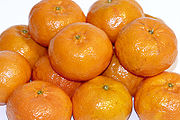Posted by: thepinetree on 12/23/2008 05:51 PM
Updated by: Kim_Hamilton on 12/23/2008 11:09 PM
Expires: 01/01/2013 12:00 AM
:

Mandarins growing appeal to consumers....A popular holiday treat, mandarin oranges are only getting better.~by Ken Churches
In the UC Riverside citrus breeding laboratory of plant geneticist Mikeal Roose, scientists spend 75 percent of their time on mandarins, aiming to develop new varieties with rich sweet flavor, bright color, few or no seeds, easy peeling and a maturity date that will extend the fruit's season beyond the winter holidays in California. Mandarins have a lot of appeal. Many on the market today are sweet, easily peeled and they split into even segments without squirting juice. A serving has just 42 calories, but provides 50 percent of the U.S. recommended dietary allowance of vitamin C.....

The number of acres planted to mandarins in California is on the rise. According to the U.S. National Agricultural Statistics Service, in 2005 there were 24,038 acres planted to mandarins in California, with 11,834 of those non-bearing. In other words, three years ago nearly half of all mandarins were newly planted. In 2008, 31,392 acres were planted to mandarins; 5,707 non-bearing.
During the same period, there was a nearly 5,000-acre reduction in the area planted to Valencia oranges, dipping from 49,163 in 2005 to 44,471 in 2008.
The director of the UC Lindcove Research and Extension Center, Beth Grafton-Cardwell, attributes the drop in Valencia acres to greater availability of imported navel oranges in the summer and the availability of newer late maturing navel varieties. Traditionally, California navels -- which are favored for their lack of seeds and thick, easy-to-remove rind -- reached maturity in the wintertime. Now navels imported from Australia and late-season California navels are meeting the demand for oranges in the northern hemisphere's summer, when Valencia oranges from California typically come on the market.
Market opportunities and pleasing fruit quality, however, aren't the only reasons Roose and his staff focus their efforts on the tasty, diminutive mandarin. Though mandarins look like oranges, from the genetic perspective, they are somewhat different. In fact, the mandarin preceded the orange.
The orange is a hybrid of ancient origin, Roose said.
"Nobody has ever been able to breed oranges," Roose said. "If you cross two oranges, all the hybrid trees produce fruit that are very unlike oranges. Because oranges are hybrids between two ancestral species, the characteristics derived from each of these ancestors produce novel combinations in the offspring of oranges."
The origin of oranges as hybrids involving pummelos and mandarins was proposed long ago, and has been confirmed by DNA evidence developed in several labs.
"The chloroplast genome in oranges, inherited from a female, came from pummelo. We can also find other genes in oranges that match pummelos and lots of others that match mandarins," Roose said. "But we still don't know which pieces of the orange genome came from mandarins and which from pummelos. That's what we're trying to figure out right now."
A better understanding of oranges' ancestry, he said, may eventually allow scientists to breed them.
The very popular Washington navel orange derived from a single natural mutation in an orchard of sweet oranges at a Brazilian monastery in 1820. The genetic mutation causes navel oranges to form an undeveloped group of small segments at the base of the fruit, and, because of the mutation, the fruit is seedless.
The most common way to propagate true-to-type edible varieties of oranges, lemons, limes and many other citrus is to graft cuttings -- called budwood -- onto rootstock trees. In effect, they are propagated by cloning.
Mandarins' history is quite different. They are thought to have originated in Southeast Asia and have spread all over the world. They can be bred, offering scientists the ability to cross varieties that have good characteristics to produce fruit that is clearly recognizable as mandarins. The scientists can then make selections of trees that produce fruit with the best characteristics. Recently released varieties include "Gold Nugget" and "Yosemite GoldTM" mandarin hybrids.
The UC Riverside Citrus Variety Collection, overseen by UC Riverside botanist Tracy Kahn, maintains and evaluates field plantings of more than 1,000 types of citrus and closely related trees in two UC facilities -- one at UC Riverside and the other in the small Tulare County community of Lindcove. Citrus varieties with the best characteristics are provided to farmers as budwood from source trees tested free of known citrus pathogens by the UC Citrus Clonal Protection Program, directed by UC Riverside plant pathologist Georgios Vidalakis.
At a recent Lindcove field day, Kahn commented about the mandarin's sometimes confusing nickname "tangerine."
At one time, mandarins were shipped to the United States from the Moroccan port city of Tangier.
"They were given the nickname tangerines, and the name stuck," Kahn said. "In the United States, we use the terms mandarin and tangerine interchangeably. However, mandarin is the botanical term that's used throughout the world."
|

